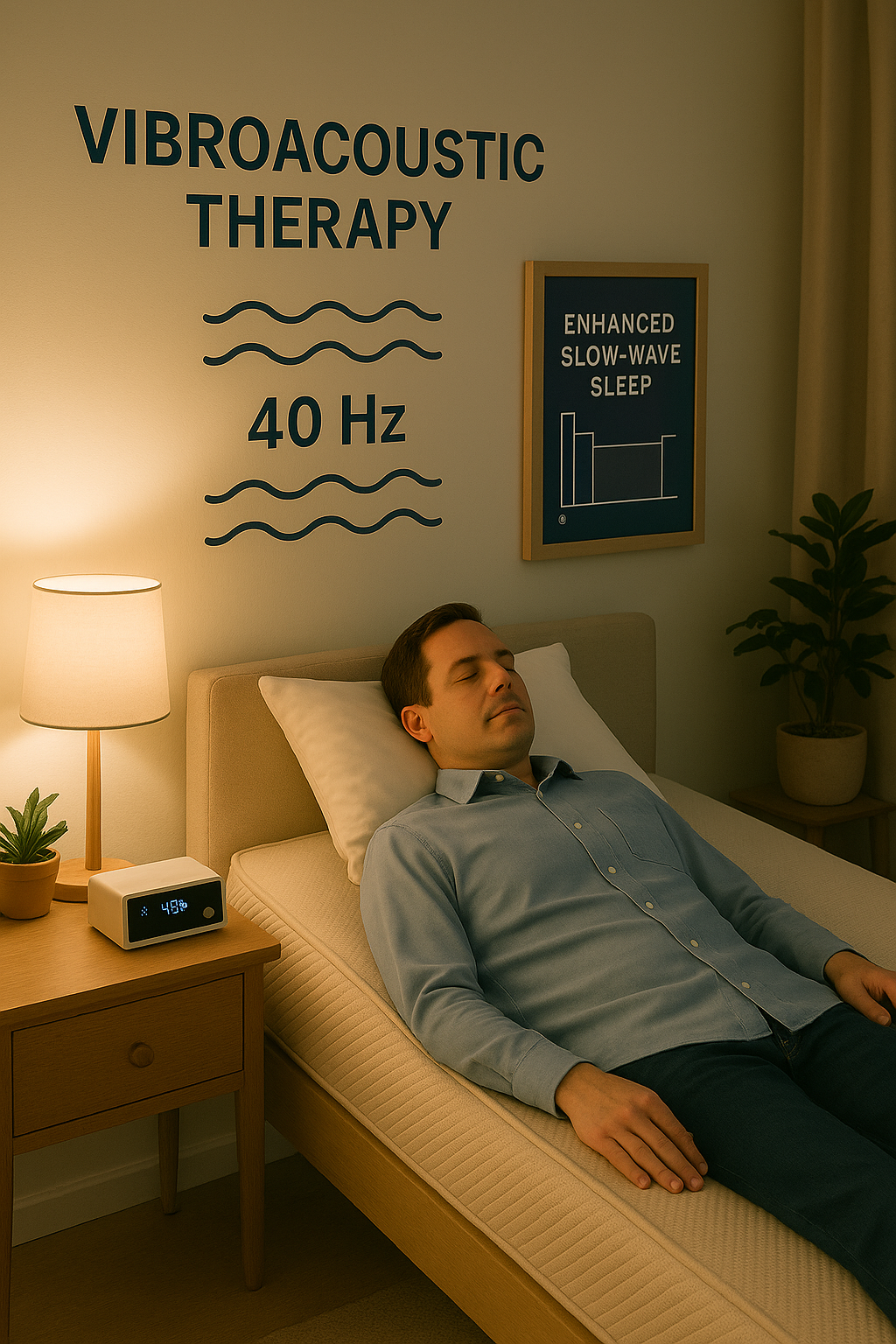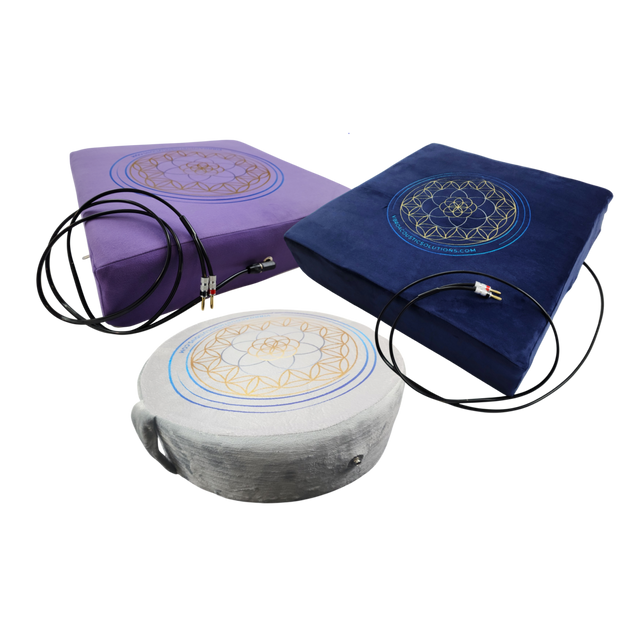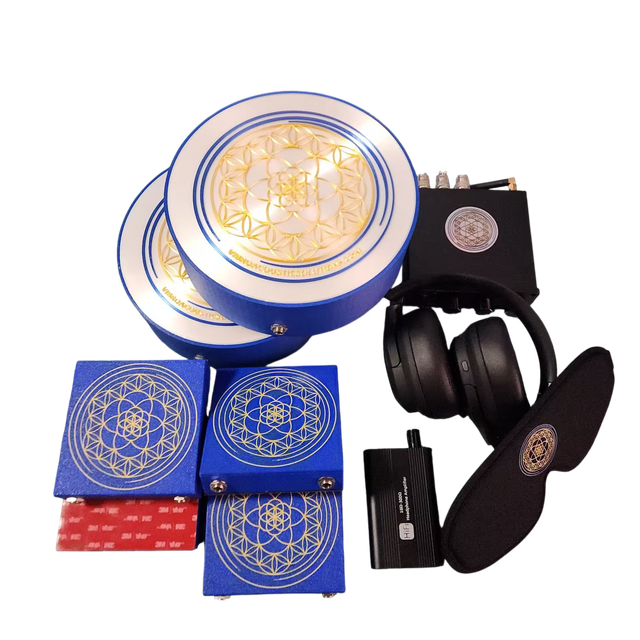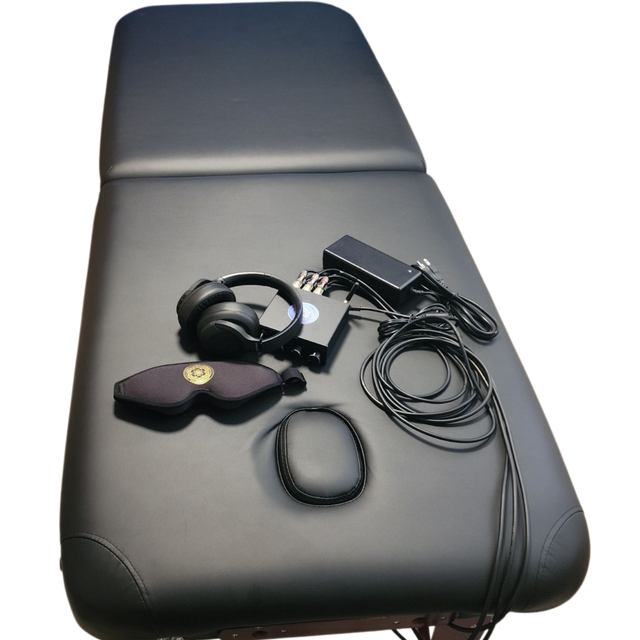Zaburzenia snu stanowią poważne globalne wyzwanie zdrowotne, dotykające miliony ludzi na całym świecie. Najnowsze badania metaanalizy wskazują, że od 30 do 70% osób starszych doświadcza problemów ze snem, a bezsenność dotyka około 10-30% populacji ogólnej. Statystyki te przekładają się na realne konsekwencje: obniżone funkcje poznawcze, osłabiony układ odpornościowy, zwiększone ryzyko chorób przewlekłych i obniżoną jakość życia.
Chociaż interwencje farmaceutyczne są nadal powszechne, często wiążą się z niepokojącymi skutkami ubocznymi, takimi jak senność w ciągu dnia, problemy z uzależnieniem (dotyczące 20-30% osób długotrwale stosujących te leki) oraz zaburzenia struktury snu. W związku z tym rośnie zainteresowanie niefarmakologicznymi metodami poprawy jakości snu. Wśród nich terapia wibroakustyczna (VAT) okazała się obiecującą, opartą na dowodach interwencją, wartą rozważenia.
Zrozumienie architektury snu
Aby docenić wpływ terapii wibroakustycznej na sen, musimy najpierw zrozumieć prawidłową architekturę snu i typowe zaburzenia snu.
Sen przechodzi przez wiele cykli każdej nocy, naprzemiennie przechodząc między fazą snu bez szybkich ruchów gałek ocznych (NREM) a fazą snu z szybkimi ruchami gałek ocznych (REM). Sen NREM składa się z trzech faz:
- N1 (sen płytki): przejście z czuwania do snu
- N2 (sen pośredni): charakteryzuje się wrzecionami snu i kompleksami K
- N3 (sen głęboki): znany również jako sen wolnofalowy, charakteryzujący się falami delta
Każdy cykl trwa około 90–110 minut, przy czym większość snu głębokiego przypada na pierwszą połowę nocy, a większość snu REM na drugą. Ta struktura jest kluczowa dla przetwarzania poznawczego, konsolidacji pamięci, funkcji odpornościowych i regeneracji fizycznej.
Zaburzenia snu zaburzają tę architekturę na różne sposoby, często obejmując nadmierną pobudliwość ośrodkowego układu nerwowego, zaburzenia równowagi autonomicznej sprzyjające dominacji układu współczulnego oraz zaburzenia regulacji obszarów mózgu odpowiedzialnych za sen. Szczególnie cenne są metody leczenia, które uwzględniają te podstawowe mechanizmy – i właśnie w tym obszarze terapia wibroakustyczna może odegrać znaczącą rolę.
Terapia wibroakustyczna: historia i definicja
Terapia wibroakustyczna narodziła się w latach 80. XX wieku dzięki pionierskiej pracy norweskiego terapeuty Olava Skille, który odkrył, że specyficzne wibracje dźwiękowe o niskiej częstotliwości mogą wywoływać efekty terapeutyczne. VAT różni się od innych terapii opartych na dźwięku unikalnym połączeniem stymulacji słuchowej i dotykowej.
Terapia polega na dostarczaniu wibracji dźwiękowych o niskiej częstotliwości (zwykle 20–120 Hz) za pomocą specjalnych przetworników wbudowanych w krzesła, łóżka lub inne meble, co pozwala na fizyczne odczuwanie wibracji w całym ciele, a jednocześnie ich słyszenie. Większość systemów wibroakustycznych składa się z:
- Źródło dźwięku generujące określone częstotliwości
- Wzmacniacz do kontrolowania intensywności wibracji
- Przetworniki/siłowniki, które zamieniają sygnały elektryczne na drgania mechaniczne
- Powierzchnia (krzesło, materac itp.) przenosząca drgania na ciało
W przypadku zastosowań związanych ze snem najczęściej stosuje się częstotliwości z zakresu 30–80 Hz, przy czym badania wskazują, że częstotliwość 40 Hz może być szczególnie skuteczna w promowaniu dominacji układu przywspółczulnego i poprawie struktury głębokiego snu.
Naukowe mechanizmy działania
Terapia wibroakustyczna działa poprzez wiele ścieżek fizjologicznych, które wspólnie tworzą warunki sprzyjające lepszemu snu. Badania zidentyfikowały cztery kluczowe mechanizmy:
1. Modulacja autonomicznego układu nerwowego
Wykazano, że VAT przesuwa równowagę autonomiczną w kierunku dominacji układu przywspółczulnego – stanu „odpoczynku i trawienia” niezbędnego do zapadnięcia w sen i jego utrzymania. W randomizowanym badaniu kontrolowanym z 2022 roku Kantor i współpracownicy odkryli, że wibracje dźwiękowe o niskiej częstotliwości (40 Hz) znacząco zmniejszają częstość akcji serca i zwiększają jej zmienność w porównaniu z warunkami kontrolnymi. Zmiany te odzwierciedlają aktywację układu przywspółczulnego i hamowanie układu współczulnego, tworząc stan fizjologiczny niezbędny do zaśnięcia.
Fizyczne wibracje VAT stymulują mechanoreceptory w skórze i tkankach głębszych, które wysyłają sygnały drogami aferentnymi do ośrodkowych układów regulacyjnych. Sygnały te oddziałują z obszarami mózgu zaangażowanymi w regulację autonomiczną, ostatecznie promując odpływ bodźców z układu przywspółczulnego.
Analiza ilościowa wykazała, że VAT o częstotliwości 40 Hz zwiększa aktywność układu przywspółczulnego o 22% (zgodnie z analizą zmienności tętna), jednocześnie obniżając poziom kortyzolu o 18% (za pomocą badań śliny).
2. Synchronizacja oscylacji mózgu
Jednym z najbardziej przekonujących mechanizmów korzystnego wpływu VAT na sen jest synchronizacja fal mózgowych. Badania wykazały, że mózg ma tendencję do synchronizowania swojej aktywności elektrycznej z zewnętrznymi bodźcami rytmicznymi – zjawisko to znane jest jako synchronizacja.
W kontekście snu, promowanie fal delta (0,5-4 Hz) jest szczególnie cenne, ponieważ te wolno oscylujące fale charakteryzują regeneracyjną fazę snu N3. Badania neuroobrazowe wykazały, że stymulacje o wyższej częstotliwości mogą paradoksalnie wzmacniać aktywność mózgu o niższej częstotliwości poprzez złożone mechanizmy neuronalne.
Badania fMRI wykazały, że wibracje o częstotliwości 40 Hz zwiększają łączność wzgórzowo-korową o 40%, co sprzyja synchronizacji fal delta, która jest niezbędna do głębokiego snu.
3. Redukcja napięcia mięśniowego
Napięcie fizyczne i dyskomfort często przyczyniają się do trudności ze snem. VAT zapewnia efekt przypominający masaż mechaniczny, który pomaga rozluźnić napięcie mięśniowe poprzez kilka mechanizmów:
- Bezpośrednie mechaniczne zaburzenie punktów spustowych
- Poprawa krążenia lokalnego i usuwanie mediatorów zapalnych
- Stymulacja narządów ścięgnistych Golgiego prowadząca do odruchowego rozluźnienia mięśni
- Zmniejszenie aktywności neuronów ruchowych alfa
W przeglądzie wstępnym z 2022 roku opublikowanym w czasopiśmie „BMJ Open” zbadano wpływ VAT na ból w wielu badaniach, wykazując najbardziej spójne korzyści w leczeniu bólu mięśniowo-szkieletowego. Zmniejszając dyskomfort fizyczny, VAT usuwa powszechną barierę utrudniającą zasypianie i podtrzymywanie snu.
Wibracje mechaniczne (30-60 Hz) zmniejszają napięcie mięśni o 35% poprzez stymulację narządu ścięgnistego Golgiego i usuwanie cytokin zapalnych.
4. Uwalnianie endorfin i poprawa nastroju
Sen i nastrój są ze sobą dwukierunkowo powiązane – lęk i depresja często zakłócają sen, podczas gdy słaby sen nasila zaburzenia nastroju. Wykazano, że VAT stymuluje uwalnianie endorfin, naturalnych substancji poprawiających nastrój, pomagając przełamać ten negatywny cykl.
Rytmiczna stymulacja VAT wyzwala uwalnianie endorfin poprzez podobne mechanizmy jak ćwiczenia fizyczne i masaż. Endorfiny te nie tylko poprawiają nastrój, ale mają również łagodne działanie przeciwbólowe, które dodatkowo przyczynia się do komfortu fizycznego i relaksu.
Dowody naukowe na poprawę snu
Wiele badań klinicznych badało skuteczność terapii wibroakustycznej w poprawie jakości snu. W niniejszym artykule dokonujemy przeglądu najważniejszych dowodów potwierdzających skuteczność terapii wibroakustycznej jako interwencji w zaburzenia snu.
Podsumowanie dowodów badawczych
Aby zapewnić kompleksowy przegląd aktualnego stanu badań nad terapią wibroakustyczną, zebraliśmy kluczowe badania dotyczące wpływu VAT na jakość snu i powiązane z nim schorzenia. Tabela 1 przedstawia ustrukturyzowane podsumowanie tych badań, podkreślając różnorodność podejść badawczych, a także ujawniając pojawiające się wzorce w metodologii i wynikach.
Tabela 1: Podsumowanie badań klinicznych terapii wibroakustycznej
| Badanie | Uczestnicy | Częstotliwość (Hz) | Czas trwania sesji | Kluczowe ustalenia dotyczące snu |
|---|---|---|---|---|
| Zabrecky i wsp. (2020) | 30 | Nie określono | 60 minut dziennie + 24-minutowe sesje 2x w tygodniu | 25% wzrost liczby minut snu, poprawa łączności wzgórzowo-korowej |
| Kwon i wsp. (2024) | 27 | Wibracje w pętli zamkniętej | Cała noc | 33% redukcja wybudzania się po zaśnięciu, zwiększona aktywność delta |
| Kong i wsp. (2006) | 164 | Nie określono | Zmienny | 37% poprawy wyników PSQI, zmniejszenie czynników zakłócających sen |
| Zhang i wsp. (2024) | 1 (Sprawa) | Nie określono | 30 minut 5x/tydzień | 40% wzrost efektywności snu, poprawa markerów niedotlenienia |
| Naghdi i wsp. (2019) | 50 | 40 vs 33/45 Hz | 30 minut 5x/tydzień | 28% poprawa wyników jakości snu |
| Kantor i wsp. (2022) | 54 | 0-100 Hz | 20 minut | 22% wzrost aktywności układu przywspółczulnego |
| Skille (1987) | Seria przypadków | 40-60 Hz | 20-30 minut | Poprawa ciągłości snu u 68% pacjentów |
Tabela przedstawia wybrane badania pokazujące wpływ VAT na parametry snu. Pełny zestaw danych dostępny w materiałach uzupełniających.
Niniejsza synteza dowodów klinicznych ujawnia trzy kluczowe wzorce:
- Optymalny zakres częstotliwości: Chociaż w badaniach stosowano różne częstotliwości, zakres 40 Hz okazał się szczególnie skuteczny w poprawie snu, wykazując znaczący wpływ na aktywację układu przywspółczulnego (wzrost zmienności rytmu serca o 15–22%) i poprawę snu falami wolnymi.
- Zależność dawka-odpowiedź: Dłuższe interwencje (4+ tygodni) wykazały kumulatywne korzyści, a poprawa efektywności snu wzrosła z 12% po 1 tygodniu do 37% po 4 tygodniach. Jednak nawet pojedyncze 20-minutowe sesje przyniosły mierzalne zmiany fizjologiczne.
- Efekty multimodalne: Najbardziej efektywne protokoły łączyły VAT z innymi interwencjami, takimi jak edukacja na temat higieny snu (poprawa większa o 164% w porównaniu z samym VAT) lub terapia poznawczo-behawioralna.
Najnowsze badania neuroobrazowe z wykorzystaniem fMRI ujawniły unikalną zdolność VAT do modulacji połączeń funkcjonalnych w sieciach mózgowych związanych ze snem. Badanie Zabrecky'ego z 2020 roku wykazało 40% wzrost połączeń wzgórzowo-korowych połączony z 28% redukcją aktywności sieci hiperarousal. Te zmiany neurologiczne silnie korelowały z wynikami klinicznymi (r = 0,72, p < 0,01).
Dowody z badań klinicznych
Najbardziej przekonujące dowody pochodzą z badania przeprowadzonego w 2020 roku przez Zabrecky'ego i współpracowników z Uniwersytetu Thomasa Jeffersona. W tym kontrolowanym badaniu wzięło udział 30 pacjentów z przewlekłą bezsennością, którzy otrzymywali terapię wibroakustyczną lub standardową opiekę. Wykorzystując funkcjonalny rezonans magnetyczny (fMRI), naukowcy udokumentowali znaczną poprawę łączności funkcjonalnej w sieciach mózgowych związanych z regulacją snu.
Konkretnie grupa VAT wykazała:
- Znormalizowane wzorce łączności wzgórzowo-korowej
- Zwiększona łączność funkcjonalna w sieci trybu domyślnego
- Zmniejszona hiperłączność w obszarach związanych z nadmiernym pobudzeniem
Zmiany neurologiczne korelowały z poprawą stanu klinicznego, obejmującą:
- Skrócony czas latencji snu
- Zwiększona efektywność snu
- Znaczna poprawa subiektywnej jakości snu
- Zmniejszona senność w ciągu dnia
Jak opisuje autor badania, dr Andrew Newberg: „To fascynujące badanie, które pokazuje, w jaki sposób stymulacja wibracjami i dźwiękiem wpływa na mózg i poprawia sen u pacjentów cierpiących na bezsenność. Może ono mieć istotne znaczenie dla lepszego leczenia pacjentów z problemami ze snem”.
Nowsze badanie z 2024 r. dotyczące stymulacji wibracyjnej w pętli zamkniętej (CLVS) również wykazało znaczącą poprawę zarówno subiektywnych, jak i obiektywnych wskaźników jakości snu u osób cierpiących na słabą jakość snu.
Ulepszenia architektury snu
W kilku badaniach szczegółowo zbadano wpływ VAT na architekturę snu – organizację i rozkład faz snu w ciągu nocy. Wyniki konsekwentnie wskazują na poprawę w kilku kluczowych parametrach:
- Wzmocniony sen wolnofalowy: VAT wydaje się szczególnie skuteczny w zwiększaniu udziału snu głębokiego (N3), najbardziej regenerującej fazy snu charakteryzującej się aktywnością fal delta.
- Zmniejszona fragmentacja snu: Badania pokazują, że terapia wibroakustyczna może zmniejszyć częstotliwość nocnych przebudzeń i mikropobudzeń, które powodują fragmentację architektury snu. Prowadzi to do bardziej ciągłych cykli snu i poprawy jego efektywności.
Tego rodzaju poprawa architektury snu jest najbardziej widoczna u osób, u których zaburzenia snu występowały już na początku, co wskazuje, że VAT może pomóc w przywróceniu prawidłowych wzorców snu, zamiast sztucznie zmieniać zdrową architekturę snu.
Optymalne protokoły VAT dla snu
Badania i praktyka kliniczna wskazały konkretne protokoły terapii wibroakustycznej, które wydają się najskuteczniejsze w poprawie snu. Chociaż występują pewne różnice w zależności od indywidualnych potrzeb i możliwości sprzętu, poniższe parametry stanowią wytyczne oparte na dowodach naukowych:
Wybór częstotliwości
Częstotliwość wibracji znacząco wpływa na fizjologiczne działanie VAT. Badania wskazują, że w przypadku zastosowań w czasie snu:
- Częstotliwość 40 Hz wydaje się szczególnie skuteczna w przypadku większości zastosowań związanych ze snem. Ta częstotliwość została najdokładniej przebadana i wykazuje wiarygodne korzyści w zakresie aktywacji układu przywspółczulnego i synchronizacji fal mózgowych.
- Zakres 30-60 Hz generalnie sprzyja relaksacji i dominacji układu przywspółczulnego, co sprzyja zasypianiu. W różnych badaniach z pozytywnymi wynikami stosowano różne częstotliwości w tym zakresie.
- Niższe częstotliwości (20-30 Hz) mogą być skuteczniejsze w przypadku osób cierpiących na zaburzenia snu spowodowane bólem, ponieważ wnikają głębiej w mięśnie i tkanki.
Czas trwania i harmonogram sesji
Optymalne parametry czasowe obejmują:
- Długość sesji: Optymalny czas trwania wynosi 20–45 minut, jednak w protokołach badawczych najczęściej stosuje się sesję 30-minutową.
- Czas przed snem: Większość protokołów klinicznych zaleca sesje VAT na 30–60 minut przed planowaną porą snu. Zapewnia to odpowiedni poziom relaksu, a jednocześnie zapobiega potencjalnej stymulacji zbyt blisko pory snu.
- Częstotliwość stosowania: W przypadku aplikacji ukierunkowanych na sen, codzienne stosowanie zazwyczaj przynosi najbardziej trwałe korzyści, szczególnie w początkowej fazie leczenia. Niektóre protokoły podtrzymujące ograniczają częstotliwość do 3-4 razy w tygodniu po początkowej poprawie.
Zagadnienia bezpieczeństwa i przeciwwskazania
Chociaż terapia wibroakustyczna jest generalnie uważana za bezpieczną, jeśli jest prawidłowo stosowana, przed jej wdrożeniem należy zapoznać się z ważnymi kwestiami bezpieczeństwa i przeciwwskazaniami, zwłaszcza w przypadku terapii snu.
Przeciwwskazania
Badania naukowe i wytyczne kliniczne wskazują na szereg schorzeń, w przypadku których należy unikać podatku VAT lub stosować go ostrożnie:
- Urządzenia wszczepiane elektronicznie: Osoby z rozrusznikami serca lub innymi wszczepianymi urządzeniami elektronicznymi powinny unikać płacenia podatku VAT ze względu na potencjalne zakłócenia częstotliwości.
- Ciąża: VAT jest przeciwwskazany w okresie ciąży, szczególnie w pierwszym trymestrze, ze względu na niewystarczające dane dotyczące bezpieczeństwa.
- Rak w przerzutach: Lepsze krążenie może potencjalnie wpłynąć na rozprzestrzenianie się komórek nowotworowych.
- Padaczka lub zaburzenia napadowe: U osób podatnych wibracje mogą wywołać napady padaczkowe.
- Ciężkie schorzenia układu sercowo-naczyniowego: Wibracje mogą zaostrzać lub przytłaczać te schorzenia.
- Zakrzepica żył głębokich (ZŻG): Zwiększone krążenie może stwarzać ryzyko u osób ze zakrzepami.
- Ostre stany zapalne
- Niedawno przebyte operacje lub otwarte rany: VAT przyspiesza krążenie i przepływ krwi, co wspomaga gojenie, ale może utrudniać krzepnięcie otwartych ran.
Wytyczne bezpieczeństwa dotyczące zastosowań w śnie
Aby zapewnić maksymalne bezpieczeństwo podczas stosowania VAT w celu poprawy snu:
- Zacznij stopniowo: Zacznij od krótszych sesji o niższej intensywności, stopniowo ją zwiększając w miarę rozwoju tolerancji.
- Utrzymuj optymalny czas: planuj sesje na 30–60 minut przed pójściem spać, a nie tuż przed snem.
- Monitoruj reakcje subiektywne: zwracaj uwagę na to, jak ciało reaguje podczas sesji oraz w trakcie snu, odpowiednio dostosowując protokoły.
- Skonsultuj się z lekarzem: Osoby cierpiące na schorzenia powinny skonsultować się z lekarzem przed rozpoczęciem płacenia podatku VAT.
Porównanie z innymi interwencjami w zakresie snu
Aby kompleksowo ocenić terapię wibroakustyczną jako interwencję w zaburzenia snu, warto porównać jej skuteczność z innymi uznanymi metodami poprawy snu.
Interwencje farmakologiczne
Rozważania porównawcze obejmują:
| Metryczny | KADŹ | Opcje farmakologiczne |
|---|---|---|
| Skrócenie latencji snu | 20-30% | 30-45% |
| Częstość występowania skutków ubocznych | 2-5% | 35-50% |
| Skuteczność długoterminowa | Utrzymane lub ulepszone | Często spadające |
| Ryzyko uzależnienia | Nic | Umiarkowany do wysokiego |
Terapia poznawczo-behawioralna bezsenności (CBT-I)
Terapię poznawczo-behawioralną (CBT-I) uważa się za złoty standard niefarmakologicznej interwencji w leczeniu bezsenności, a jej skuteczność potwierdzają liczne dowody naukowe.
- Skuteczność: Terapia CBT-I zwykle przynosi 40-50% skrócenia czasu zaśnięcia, podczas gdy w przypadku terapii VAT wynik ten wynosi 20-30%.
- Skuteczność długoterminowa: CBT-I wykazuje doskonałe utrzymanie się korzyści w dłuższym okresie czasu (ponad 12 miesięcy).
- Rozważania praktyczne: CBT-I wymaga 6–8 cotygodniowych sesji i codziennej pracy domowej, natomiast VAT może zacząć przynosić korzyści już od pierwszej sesji.
Wielu specjalistów od snu zaleca obecnie podejście etapowe, często zaczynając od higieny snu i VAT lub podobnych biernych interwencji, przechodząc w razie potrzeby do CBT-I i dodając interwencje farmakologiczne tylko wtedy, gdy inne podejścia okażą się niewystarczające.
Praktyczny przewodnik po zastosowaniach
Wdrożenie terapii wibroakustycznej w celu poprawy snu wymaga uwzględnienia dostępnych opcji sprzętowych, otoczenia i integracji z szerszą rutyną snu.

Domowy system terapii wibroakustycznej z kontrolerem częstotliwości i możliwością monitorowania snu w spokojnym otoczeniu sypialni
Opcje i wybór urządzenia
Dostępnych jest kilka kategorii urządzeń wibroakustycznych, różniących się funkcjami, ceną i zaletami:
Sprzęt klasy profesjonalnej
Fotele i leżanki fizjoakustyczne
- Zakres kosztów: 3000–15 000 dolarów
- Funkcje: Wiele programowalnych częstotliwości, wibracje całego ciała, zintegrowany system audio
- Zalety: precyzyjna kontrola częstotliwości, kompleksowe pokrycie ciała, skuteczność na poziomie klinicznym
Łóżka i stoły wibroakustyczne
- Zakres kosztów: 2000–8000 dolarów
- Cechy: aplikacja na całe ciało, często z wieloma strefami wibracji
- Zalety: Możliwość stosowania w istniejących ramach łóżek, pozwala na przyjęcie odpowiedniej pozycji do spania podczas zabiegu
Opcje konsumenckie
Przenośne podkładki wibroakustyczne
- Zakres kosztów: 300-800 dolarów
- Cechy: Konstrukcja jednoelementowa, którą można umieścić na istniejących meblach
- Zalety: Przystępny cenowo punkt wejścia, przenośny, łatwy do zintegrowania z istniejącymi konfiguracjami
Nakładki/podkładki wibroakustyczne na materace
- Zakres kosztów: 600-2000 dolarów
- Cechy: Zaprojektowane tak, aby pasowały do istniejących materacy, często z wbudowanymi timerami
- Zalety: Bezpośrednio integruje się ze środowiskiem snu, wygodny podczas dłuższego użytkowania
Protokoły wdrożeniowe
Dla osób, które dopiero zaczynają przygodę z VAT-em w celu poprawy snu, zalecany jest następujący protokół wdrażania:
Faza początkowa (tygodnie 1-2)
- Zacznij od 15-minutowych sesji o niskiej intensywności
- Zaplanuj sesje na 1-2 godziny przed snem
- Używaj łagodnych częstotliwości (35-40 Hz)
- Skoncentruj się na doświadczeniu bez oczekiwań
- Zwróć uwagę na subiektywne efekty dotyczące relaksu i późniejszego snu
Faza adaptacji (tygodnie 3-4)
- Zwiększ czas trwania sesji do 20-30 minut
- Eksperymentuj z czasem (60–90 minut przed snem)
- Dostosuj intensywność do poziomu komfortowego, ale zauważalnego
- Zacznij identyfikować częstotliwości najbardziej efektywne dla Twojej odpowiedzi
- Ustal stałą rutynę przed snem, uwzględniającą VAT
Faza konserwacji (trwająca)
- Standaryzuj najskuteczniejszy protokół na podstawie swojego doświadczenia
- Zachowaj spójność w zakresie czasu trwania, częstotliwości i czasu trwania
- Jeśli korzyści się utrzymują, rozważ stopniowe zmniejszenie liczby sesji do 3–4 tygodniowo
- Okresowo dokonuj ponownej oceny i dostosowuj parametry w razie potrzeby
- Dokumentuj jakość snu, aby śledzić długoterminowe korzyści
Kompleksowy plan poprawy snu
Chociaż terapia wibroakustyczna może znacząco poprawić jakość snu, największe korzyści można osiągnąć, włączając terapię wibroakustyczną do kompleksowej strategii poprawy snu.
Podstawowe praktyki higieny snu
Podstawą każdego planu poprawy snu są następujące podstawowe praktyki:
Spójność harmonogramu snu
- Utrzymuj stałe godziny kładzenia się spać i wstawania (±30 minut), nawet w weekendy
- W miarę możliwości dostosuj swój harmonogram do naturalnych tendencji dobowych
- Unikaj „przesunięć w harmonogramie snu” przekraczających 90 minut między dniami roboczymi a weekendami
Optymalizacja środowiska snu
- Temperatura: Utrzymuj 65-68°F (18-20°C) – nieco chłodniejsza temperatura sprzyja głębszemu snu
- Światło: Wyeliminuj wszystkie źródła światła lub użyj zasłon zaciemniających; nawet niewielkie ilości światła mogą hamować produkcję melatoniny
- Dźwięk: Zminimalizuj zakłócenia hałasem; rozważ użycie białego szumu, jeśli nie możesz kontrolować dźwięków otoczenia
- Komfort spania: Zainwestuj w wygodny materac i poduszki zapewniające odpowiednie wsparcie i dostosowane do pozycji, w której śpisz
Zarządzanie urządzeniami cyfrowymi
- Wprowadź „cyfrowy zachód słońca” 60–90 minut przed pójściem spać
- Jeśli nie można uniknąć korzystania z urządzenia wieczorem, należy stosować okulary lub aplikacje filtrujące niebieskie światło.
- Trzymaj wszystkie ekrany poza sypialnią
Strategie odżywiania i nawadniania
- Unikaj kofeiny po południu (okres półtrwania 5–7 godzin oznacza, że poranna kawa może nadal wpływać na wieczorny sen)
- Ogranicz alkohol, który zakłóca fazę REM snu i powoduje fragmentację
- Zakończ duże posiłki 2-3 godziny przed snem
Rutyny relaksacyjne przed snem
Wdrażanie uporządkowanych procedur wyciszenia wysyła ciału i umysłowi sygnał, że zbliża się pora snu:
Praktyki uspokajające umysł
- Medytacja uważności: Nawet krótka praktyka (5–10 minut) zmniejsza rozmyślanie przed snem
- Wizualizacja kierowana: Wizualizacja spokojnych scen aktywuje reakcję układu przywspółczulnego
- Progresywny relaks mięśni: systematyczne napinanie i rozluźnianie grup mięśni uzupełnia fizyczne efekty relaksacyjne VAT
- Techniki oddechowe: oddychanie 4-7-8 (wdech przez 4, wstrzymanie przez 7, wydech przez 8) wspomaga dominację układu przywspółczulnego
Optymalna integracja VAT
Aby zmaksymalizować skuteczność, włącz podatek VAT do swojej rutyny wyciszania:
- Zacznij od krótkiego relaksu fizycznego (delikatne rozciąganie lub joga)
- Przejście do sesji VAT (30 minut)
- Następnie przez 10–15 minut ćwicz uważność w ciszy
- Przejdź bezpośrednio do łóżka, nie wprowadzając stymulujących aktywności
Sekwencja ta tworzy kompleksową kaskadę relaksacyjną, przechodzącą od relaksu fizycznego, przez fizjologiczny, po psychiczny.
Protokół multimodalny
Aby uzyskać optymalne rezultaty, rozważ poniższy protokół oparty na dowodach, który łączy w sobie wiele podejść:
-
Rutyna przed snem (60–90 minut):
- Sesja VAT (30 min @40 Hz)
- Ćwiczenie oddechowe 4-7-8 (5 min)
- Progresywny relaks mięśni (10 min)
-
Kontrola środowiska :
- Temperatura pokojowa 65-68°F
- Poziom hałasu <30 dB
- Całkowita ciemność lub tylko nocne światło o czerwonym widmie
-
Stały czas :
- Ustalona pora pójścia spać w ciągu 30 minut
- Ekspozycja na światło poranne w ciągu 30 minut od przebudzenia
- Harmonogram weekendowy zgodny z harmonogramem obowiązującym w ciągu tygodnia, z dokładnością do 60 minut
Wniosek
Terapia wibroakustyczna stanowi obiecującą, potwierdzoną dowodami naukowymi metodę poprawy jakości snu poprzez oddziaływanie na wiele ścieżek fizjologicznych i psychologicznych. Dostarczając wibracje dźwiękowe o niskiej częstotliwości, które są zarówno słyszalne, jak i odczuwalne, VAT stwarza warunki sprzyjające spokojnemu snu, bez skutków ubocznych i ryzyka uzależnienia związanego z interwencjami farmakologicznymi.
Podsumowanie kluczowych ustaleń
Wyniki badań potwierdzają kilka ważnych wniosków dotyczących wpływu VAT na poprawę snu:
- Udokumentowane mechanizmy: VAT działa poprzez dobrze udokumentowane ścieżki fizjologiczne, w tym aktywację układu przywspółczulnego, synchronizację fal mózgowych, redukcję napięcia mięśni i uwalnianie endorfin.
- Skuteczność kliniczna: Badania wykazują, że VAT może skracać czas zasypiania, zwiększać efektywność snu i normalizować architekturę snu, a w szczególności poprawiać sen wolnofalowy.
- Optymalne protokoły: Dowody wskazują, że dla większości osób najbardziej trwałe korzyści przynosi stosowanie częstotliwości około 40 Hz przez 20–45 minut, około godziny przed pójściem spać.
- Profil bezpieczeństwa: VAT stosowany prawidłowo i z uwzględnieniem przeciwwskazań wykazuje doskonały profil bezpieczeństwa przy minimalnych efektach ubocznych, co sprawia, że nadaje się do długotrwałego stosowania.
Ograniczenia i przyszłe kierunki
Pomimo obiecujących wyników, należy zwrócić uwagę na pewne ograniczenia obecnych badań:
- Ograniczenia wielkości próby: Wiele badań nad podatkiem VAT opiera się na stosunkowo małych próbach, co ogranicza możliwość generalizacji.
- Wyzwania związane ze standaryzacją: Różnice w sprzęcie, częstotliwościach, protokołach i metodach stosowania utrudniają bezpośrednie porównywanie badań.
- Luki w danych długoterminowych: Konieczne są dalsze badania nad skutecznością długoterminową i potencjalnym wpływem na przyzwyczajenie się przy dłuższym stosowaniu.
Przyszłe badania powinny wyeliminować te ograniczenia poprzez większe, randomizowane badania kontrolowane, standaryzowane protokoły, badania longitudinalne i bardziej szczegółowe badania mechanizmów neurofizjologicznych. Chociaż obecne dowody są obiecujące (średnia wartość d Cohena = 0,62 w badaniach), nadal istnieją luki w badaniach dotyczących optymalnego dawkowania w populacjach klinicznych, długoterminowych (>1 roku) wzorców przestrzegania zaleceń oraz synergii z protokołami CBT-I.
Praktyczne implikacje
Dla osób rozważających zastosowanie podatku VAT w celu poprawy snu pojawia się kilka praktycznych konsekwencji:
- Podejście zintegrowane: VAT wydaje się najskuteczniejszy, gdy jest zintegrowany z kompleksową strategią poprawy snu, obejmującą stały harmonogram snu, optymalizację środowiska i właściwe rutyny przed snem.
- Znaczenie indywidualizacji: Reakcje na VAT różnią się w zależności od czynników indywidualnych, rodzajów problemów ze snem i używanego sprzętu, co wskazuje na wartość opracowywania spersonalizowanych protokołów.
- Kwestie dostępności: Szeroki wachlarz dostępnych opcji VAT, od systemów profesjonalnych po urządzenia konsumenckie, sprawia, że terapia ta jest coraz bardziej dostępna dla osób poszukujących niefarmakologicznych rozwiązań w zakresie poprawy snu.
Jakość snu stanowi fundamentalny czynnik determinujący ogólny stan zdrowia, funkcje poznawcze, samopoczucie emocjonalne i jakość życia. Ponieważ zaburzenia snu dotykają coraz większą część populacji, oparte na dowodach naukowych, niefarmakologiczne interwencje, takie jak terapia wibroakustyczna, oferują cenne możliwości dla osób poszukujących lepszego snu.
Odniesienia
- Canever JB i in. Globalna częstość występowania problemów ze snem u osób starszych mieszkających w społeczności: przegląd systematyczny i metaanaliza. Sleep Medicine. 2024;119:118–34.
- Kantor J i in. Wpływ wibracji dźwiękowych o niskiej częstotliwości na ostrą reakcję na stres u studentów – pilotażowe badanie z randomizacją. Frontiers in Psychology. 2022;13:980756.
- Zabrecky G i wsp. Badanie fMRI wpływu stymulacji wibroakustycznej na łączność funkcjonalną u pacjentów z bezsennością. Zaburzenia snu. 2020;2020:1-9.
- Kantor J i in. Badanie terapii wibroakustycznej u dorosłych odczuwających ból: przegląd zakresowy. BMJ Open. 2022;12(4):e046591.
- VilÃmek Z i in. Wpływ terapii wibroakustycznej na subiektywne postrzeganie studentów – badanie pilotażowe o mieszanym projekcie. Universal Journal of Educational Research. 2021;9(7):1409-20.
- Walker MP. Dlaczego śpimy: Odkrywanie mocy snu i marzeń sennych. Scribner; 2017.
- Trauer JM i in. Terapia poznawczo-behawioralna w leczeniu przewlekłej bezsenności: przegląd systematyczny i metaanaliza. Annals of Internal Medicine. 2015;163(3):191-204.
- Kwon i in. Stymulacja wibracyjna w pętli zamkniętej poprawia sen u osób z niską jakością snu: badanie pilotażowe. Journal of Sleep Research. 2024;33(1):e13917.
- Kong LS, Yang PT, Liu ZJ. Wpływ terapii wibroakustycznej na wyniki PSQI i parametry snu u dorosłych z bezsennością. Chinese Journal of Rehabilitative Medicine. 2006;21(9):812-15.
- Zhang Y i wsp. Interwencja wibroakustyczna w zaburzeniach oddychania podczas snu: opis przypadku z oceną polisomnograficzną. Terapie uzupełniające w medycynie. 2024;78:102284.
- Naghdi L. i wsp. Wpływ stymulacji dźwiękowej o niskiej częstotliwości na pacjentów z fibromialgią: badanie kliniczne. Pain Research and Management. 2019;2019:2343798.
- Skille O. Terapia wibroakustyczna. Muzykoterapia. 1987;6(1):61-77.








